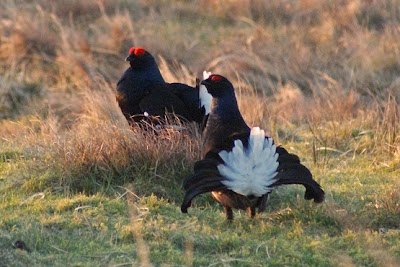 |
| Black grouse are a key species at Corehead |
The Heather Trust was recently invited to visit Corehead
Farm, one of the Borders Forest Trust's (BFT) properties North of Moffat. The
farm includes the spectacular Devil’s Beeftub, an iconic feature of the
Southern Uplands which lies at the top of Annandale where the hills run
together to form a deep and extremely steep sided hollow.
The Borders Forest Trust bought Corehead in 2009 and began
to plant up large areas of the site in a bid to recreate the historic Ettrick
Forest which once lay right across the Southern Uplands. Using native tree
species, a huge amount of planting has taken place during the intervening years
and a major part of the process has involved stock-proof exclosures to protect
the young trees.
Relieved from grazing, some interesting things have been
happening to the heather where it still survives after centuries of sheep, and
we were called in to consult on progress with the project so far, as well as
provide some advice for the future of the heather. The site also provides a home
to a small population of black grouse, and while the project aims to improve
biodiversity across the board, these birds provide a useful focus for habitat
work.
After several years without any grazing, some parts of
Corehead are looking excellent and an area of steep ground we visited could
soon provide some excellent habitat for ring ouzels, which already breed in the
area. Encroaching bracken will need to be controlled, and the nature of the
ground is such that helicopter spraying may be the only workable solution.
Elsewhere, there are potentially serious problems with
under-grazing within the exclosures, and much of the heather which has
recovered as a result of excluding livestock now risks being smothered by
molinia grass and star moss, both of which can dominate vegetation. In an ideal
world, these plants could be selectively grazed and controlled by native hill
breed cattle, but the trees must get precedent and any attempt to control the
grasses would surely come at the expense of the new trees.
Corehead is a fascinating project, and while the farm will
never be dominated by heather, low heather coverage is sure to be a key issue in
the project’s future. During our walk, we discovered a juvenile black grouse
feather which suggests that there has been successful breeding in 2014, and
while the local population of birds has been badly suppressed by habitat
fragmentation, commercial woodland and overgrazing, there is some sign of
promise in the new plantations.
With some judicious predator control and ongoing
habitat management, this area of the Borders could support a healthier population
of birds, and the potential for heather recovery gives the hill a sunny
outlook, despite being steeped in thick cloud on the day of our visit.
No comments:
Post a Comment